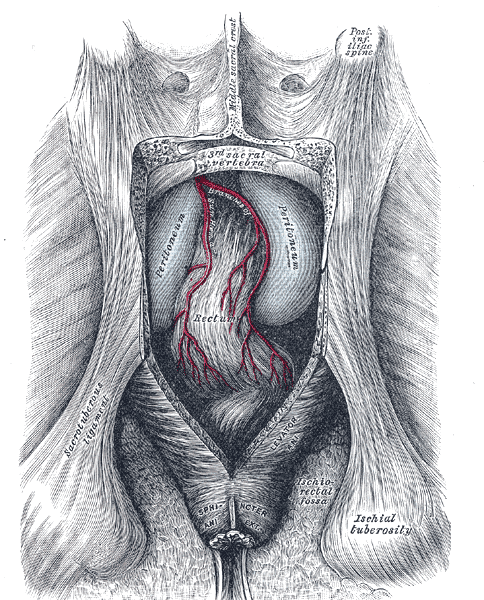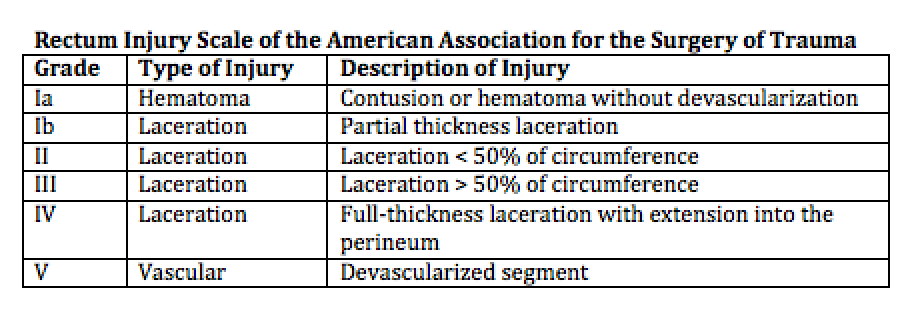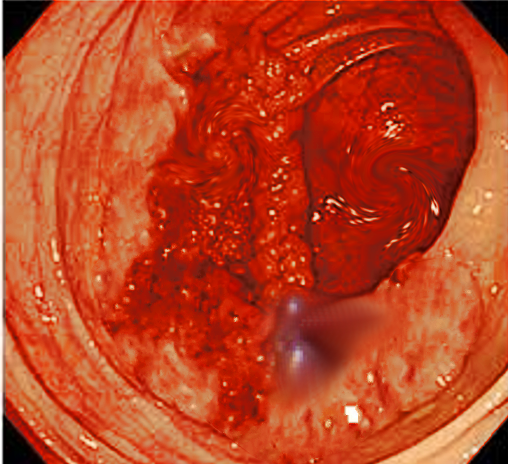[1]
OGILVIE WH. Surgical advances during the war. Journal of the Royal Army Medical Corps. 1945 Dec:85():259-65
[PubMed PMID: 21011547]
Level 3 (low-level) evidence
[2]
Ogilvie WH. Surgical Lessons of War applied to Civil Practice. British medical journal. 1945 May 5:1(4400):619-23
[PubMed PMID: 20786044]
[3]
OGILVIE WH. Abdominal wounds in the Western Desert. Bulletin of the U.S. Army Medical Department. United States. Army. Medical Department. 1946 Oct:6(4):435-45
[PubMed PMID: 20275008]
[4]
Steele SR, Maykel JA, Johnson EK. Traumatic injury of the colon and rectum: the evidence vs dogma. Diseases of the colon and rectum. 2011 Sep:54(9):1184-201. doi: 10.1007/DCR.0b013e3182188a60. Epub
[PubMed PMID: 21825901]
[5]
Demetriades D, Karaiskakis M, Toutouzas K, Alo K, Velmahos G, Chan L. Pelvic fractures: epidemiology and predictors of associated abdominal injuries and outcomes. Journal of the American College of Surgeons. 2002 Jul:195(1):1-10
[PubMed PMID: 12113532]
[6]
Aihara R, Blansfield JS, Millham FH, LaMorte WW, Hirsch EF. Fracture locations influence the likelihood of rectal and lower urinary tract injuries in patients sustaining pelvic fractures. The Journal of trauma. 2002 Feb:52(2):205-8; discussion 208-9
[PubMed PMID: 11834976]
[7]
Giannoudis PV, Grotz MR, Tzioupis C, Dinopoulos H, Wells GE, Bouamra O, Lecky F. Prevalence of pelvic fractures, associated injuries, and mortality: the United Kingdom perspective. The Journal of trauma. 2007 Oct:63(4):875-83
[PubMed PMID: 18090020]
Level 3 (low-level) evidence
[8]
Hudolin T, Hudolin I. The role of primary repair for colonic injuries in wartime. The British journal of surgery. 2005 May:92(5):643-7
[PubMed PMID: 15800953]
[9]
Demetriades D, Murray JA, Chan L, Ordoñez C, Bowley D, Nagy KK, Cornwell EE 3rd, Velmahos GC, Muñoz N, Hatzitheofilou C, Schwab CW, Rodriguez A, Cornejo C, Davis KA, Namias N, Wisner DH, Ivatury RR, Moore EE, Acosta JA, Maull KI, Thomason MH, Spain DA, Committee on Multicenter Clinical Trials. American Association for the Surgery of Trauma. Penetrating colon injuries requiring resection: diversion or primary anastomosis? An AAST prospective multicenter study. The Journal of trauma. 2001 May:50(5):765-75
[PubMed PMID: 11371831]
Level 2 (mid-level) evidence
[10]
Schipper IB, Schep N. [ATLS - a pioneer in trauma education; history and effects]. Nederlands tijdschrift voor geneeskunde. 2017:161():D1569
[PubMed PMID: 28466801]
[11]
Engles S, Saini NS, Rathore S. Emergency Focused Assessment with Sonography in Blunt Trauma Abdomen. International journal of applied & basic medical research. 2019 Oct-Dec:9(4):193-196. doi: 10.4103/ijabmr.IJABMR_273_19. Epub 2019 Oct 11
[PubMed PMID: 31681541]
[12]
Ball CG, Jafri SM, Kirkpatrick AW, Rajani RR, Rozycki GS, Feliciano DV, Wyrzykowski AD. Traumatic urethral injuries: does the digital rectal examination really help us? Injury. 2009 Sep:40(9):984-6. doi: 10.1016/j.injury.2009.03.003. Epub 2009 Jun 16
[PubMed PMID: 19535063]
[13]
Esposito TJ, Ingraham A, Luchette FA, Sears BW, Santaniello JM, Davis KA, Poulakidas SJ, Gamelli RL. Reasons to omit digital rectal exam in trauma patients: no fingers, no rectum, no useful additional information. The Journal of trauma. 2005 Dec:59(6):1314-9
[PubMed PMID: 16394903]
[14]
Shlamovitz GZ, Mower WR, Bergman J, Crisp J, DeVore HK, Hardy D, Sargent M, Shroff SD, Snyder E, Morgan MT. Poor test characteristics for the digital rectal examination in trauma patients. Annals of emergency medicine. 2007 Jul:50(1):25-33, 33.e1
[PubMed PMID: 17391807]
[15]
Porter JM, Ursic CM. Digital rectal examination for trauma: does every patient need one? The American surgeon. 2001 May:67(5):438-41
[PubMed PMID: 11379644]
[16]
Hargraves MB, Magnotti LJ, Fischer PE, Schroeppel TJ, Zarzaur BL, Fabian TC, Croce MA. Injury location dictates utility of digital rectal examination and rigid sigmoidoscopy in the evaluation of penetrating rectal trauma. The American surgeon. 2009 Nov:75(11):1069-72
[PubMed PMID: 19927507]
[17]
Shanmuganathan K, Mirvis SE, Chiu WC, Killeen KL, Scalea TM. Triple-contrast helical CT in penetrating torso trauma: a prospective study to determine peritoneal violation and the need for laparotomy. AJR. American journal of roentgenology. 2001 Dec:177(6):1247-56
[PubMed PMID: 11717058]
[18]
Shanmuganathan K, Mirvis SE, Chiu WC, Killeen KL, Hogan GJ, Scalea TM. Penetrating torso trauma: triple-contrast helical CT in peritoneal violation and organ injury--a prospective study in 200 patients. Radiology. 2004 Jun:231(3):775-84
[PubMed PMID: 15105455]
[19]
Weinberg JA, Fabian TC, Magnotti LJ, Minard G, Bee TK, Edwards N, Claridge JA, Croce MA. Penetrating rectal trauma: management by anatomic distinction improves outcome. The Journal of trauma. 2006 Mar:60(3):508-13; discussion 513-14
[PubMed PMID: 16531847]
[20]
Bosarge PL, Como JJ, Fox N, Falck-Ytter Y, Haut ER, Dorion HA, Patel NJ, Rushing A, Raff LA, McDonald AA, Robinson BR, McGwin G Jr, Gonzalez RP. Management of penetrating extraperitoneal rectal injuries: An Eastern Association for the Surgery of Trauma practice management guideline. The journal of trauma and acute care surgery. 2016 Mar:80(3):546-51. doi: 10.1097/TA.0000000000000953. Epub
[PubMed PMID: 26713970]
[21]
Hendren S, Hammond K, Glasgow SC, Perry WB, Buie WD, Steele SR, Rafferty J. Clinical practice guidelines for ostomy surgery. Diseases of the colon and rectum. 2015 Apr:58(4):375-87. doi: 10.1097/DCR.0000000000000347. Epub
[PubMed PMID: 25751793]
Level 1 (high-level) evidence
[22]
Robertson JP, Puckett J, Vather R, Jaung R, Bissett I. Early closure of temporary loop ileostomies: a systematic review. Ostomy/wound management. 2015 May:61(5):50-7
[PubMed PMID: 25965092]
Level 1 (high-level) evidence
[23]
Chow A, Tilney HS, Paraskeva P, Jeyarajah S, Zacharakis E, Purkayastha S. The morbidity surrounding reversal of defunctioning ileostomies: a systematic review of 48 studies including 6,107 cases. International journal of colorectal disease. 2009 Jun:24(6):711-23. doi: 10.1007/s00384-009-0660-z. Epub 2009 Feb 17
[PubMed PMID: 19221766]
Level 3 (low-level) evidence
[24]
Krouse RS, Grant M, Wendel CS, Mohler MJ, Rawl SM, Baldwin CM, Coons SJ, McCorkle R, Ko CY, Schmidt CM. A mixed-methods evaluation of health-related quality of life for male veterans with and without intestinal stomas. Diseases of the colon and rectum. 2007 Dec:50(12):2054-66
[PubMed PMID: 17701071]
Level 2 (mid-level) evidence
[25]
Clemens MS, Heafner TA, Watson JD, Aden JK 3rd, Rasmussen TE, Glasgow SC. Quality of Life in United States Veterans With Combat-Related Ostomies From Iraq and Afghanistan. Military medicine. 2016 Nov:181(11):e1569-e1574
[PubMed PMID: 27849491]
Level 2 (mid-level) evidence
[26]
Gonzalez RP, Phelan H 3rd, Hassan M, Ellis CN, Rodning CB. Is fecal diversion necessary for nondestructive penetrating extraperitoneal rectal injuries? The Journal of trauma. 2006 Oct:61(4):815-9
[PubMed PMID: 17033545]
[27]
Keller DS, Tahilramani RN, Flores-Gonzalez JR, Mahmood A, Haas EM. Transanal Minimally Invasive Surgery: Review of Indications and Outcomes from 75 Consecutive Patients. Journal of the American College of Surgeons. 2016 May:222(5):814-22. doi: 10.1016/j.jamcollsurg.2016.02.003. Epub 2016 Feb 13
[PubMed PMID: 27016903]
[28]
Althumairi AA, Gearhart SL. Local excision for early rectal cancer: transanal endoscopic microsurgery and beyond. Journal of gastrointestinal oncology. 2015 Jun:6(3):296-306. doi: 10.3978/j.issn.2078-6891.2015.022. Epub
[PubMed PMID: 26029457]
[29]
Cleary RK, Pomerantz RA, Lampman RM. Colon and rectal injuries. Diseases of the colon and rectum. 2006 Aug:49(8):1203-22
[PubMed PMID: 16858663]
[30]
Osterberg EC, Veith J, Brown CVR, Sharpe JP, Musonza T, Holcomb JB, Bui E, Bruns B, Hopper HA, Truitt M, Burlew CC, Schellenberg M, Sava J, Van Horn J, AAST Contemporary Management of Rectal Injuries Study Group. Concomitant bladder and rectal injuries: Results from the American Association for the Surgery of Trauma Multicenter Rectal Injury Study Group. The journal of trauma and acute care surgery. 2020 Feb:88(2):286-291. doi: 10.1097/TA.0000000000002451. Epub
[PubMed PMID: 31343599]
[31]
Clemens MS, Peace KM, Yi F. Rectal Trauma: Evidence-Based Practices. Clinics in colon and rectal surgery. 2018 Jan:31(1):17-23. doi: 10.1055/s-0037-1602182. Epub 2017 Dec 19
[PubMed PMID: 29379403]
[32]
Brown CVR, Teixeira PG, Furay E, Sharpe JP, Musonza T, Holcomb J, Bui E, Bruns B, Hopper HA, Truitt MS, Burlew CC, Schellenberg M, Sava J, VanHorn J, Eastridge PB, Cross AM, Vasak R, Vercruysse G, Curtis EE, Haan J, Coimbra R, Bohan P, Gale S, Bendix PG, AAST Contemporary Management of Rectal Injuries Study Group. Contemporary management of rectal injuries at Level I trauma centers: The results of an American Association for the Surgery of Trauma multi-institutional study. The journal of trauma and acute care surgery. 2018 Feb:84(2):225-233. doi: 10.1097/TA.0000000000001739. Epub
[PubMed PMID: 29140953]
[33]
Tsang B, McKee J, Engels PT, Paton-Gay D, Widder SL. Compliance to advanced trauma life support protocols in adult trauma patients in the acute setting. World journal of emergency surgery : WJES. 2013 Oct 2:8(1):39. doi: 10.1186/1749-7922-8-39. Epub 2013 Oct 2
[PubMed PMID: 24088362]
[34]
Murphy M, McCloughen A, Curtis K. The impact of simulated multidisciplinary Trauma Team Training on team performance: A qualitative study. Australasian emergency care. 2019 Mar:22(1):1-7. doi: 10.1016/j.auec.2018.11.003. Epub 2018 Dec 10
[PubMed PMID: 30998866]
Level 2 (mid-level) evidence
[35]
Sarani B, Paspulati RM, Hambley J, Efron D, Martinez J, Perez A, Bowles-Cintron R, Yi F, Hill S, Meyer D, Maykel J, Attalla S, Kochman M, Steele S. A multidisciplinary approach to diagnosis and management of bowel obstruction. Current problems in surgery. 2018 Oct:55(10):394-438. doi: 10.1067/j.cpsurg.2018.09.001. Epub 2018 Sep 22
[PubMed PMID: 30526888]



